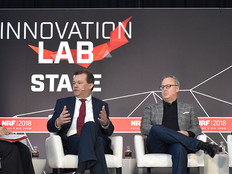Retailers Can Make Targeted Investments to Achieve Digital Transformation
Inventory management solutions give retail locations and their employees the ability to transact from anywhere in the store, together with instant access to mission-critical information.
Much of this work focuses on improving and connecting employee-facing systems and tools. But increasingly, customers want to access inventory information themselves.
While it can be daunting to think about just how many different IT tools and systems touch inventory management, retailers don't need to tackle everything at once. In many cases, even small, piecemeal improvements can yield significant results.
SIGN UP: Get more news from the BizTech newsletter in your inbox every two weeks!
Investments in inventory management technologies can help retailers achieve the following capabilities:
Technology Investments Enable New Retail Experiences
- Real-Time Visibility — By rearchitecting and connecting back-end systems, retailers can achieve real-time visibility into their inventory. That applies to not only the immediate location, but also other stores and fulfillment centers. And by equipping floor employees with mobile devices capable of accessing this information in real time, stores can give them the ability to help customers find out instantly whether items are in stock at a nearby location or can be shipped to their homes — perhaps saving an otherwise lost sale.
- Bridge Gaps Between Online and In-Store Demand — Unified inventory management systems can help retailers keep the products they need in stock, where they need them, when customers want them. When inventory systems are disconnected, a retailer might sell out of an item at its physical stores, while the same item sits in bulk in a fulfillment warehouse, ready to ship for nonexistent online orders. But with connected systems, retailers gain inventory and supply chain predictability. Mobile applications also give managers and employees the ability to help customers order the items they need. While nearly any mobility initiative will rely on widely available "off-the-shelf" mobile apps, retail is an industry that depends on purpose-built custom apps.
- Cut Down on Lines in Stores — With mobile point-of-sale systems, employees can check out shoppers anywhere in the store, improving customer service and reducing lines at the cash wrap. The use of customer data in clienteling processes can increase the quality of these interactions, providing sales staff with information they need to better serve shoppers. It is important for retailers to manage mobile devices used by employees with enterprise mobility management tools. The level of management and monitoring will depend on employee role, device type and use case. Most retailers will want to be able to track, remotely wipe and, in some cases, control the digital access on mobile devices.
- Endless Aisle — In-store tablets or kiosks can give customers access to virtual catalogs, creating an "endless aisle" that lets shoppers choose from far more products than could ever be shelved in a physical store. This feature helps brick-and-mortar retailers compete with online retailers by giving customers more options. It also helps to prevent situations in which customers walk out without making a purchase because a store didn't have what they were looking for.
- Increased Customer Engagement — By connecting back-end inventory management solutions to customer-facing technologies, retailers can create a unified, engaging experience. With radio-frequency identification (RFID) tagging, mobile beacons, digital signage and mobile apps, retailers have everything they need to know the location of all their products and the location of many of their customers — with multiple ways of transmitting messages and deals to shoppers. This is an emerging space, and it's important to tread carefully, avoiding situations in which customers feel put off.
Retailers Must Modernize IT Infrastructure
As retailers implement new tools to improve inventory management processes, it may also be necessary to upgrade or refresh back-end infrastructure and other IT equipment.
This is a good opportunity to take a close look at existing investments in networking, the data center, wireless and the cloud.
Retailers can then determine whether they need additional resources in servers and storage, virtualization, wide area network optimization, wireless access points or cloud deployments (including Infrastructure as a Service and Software as a Service).
Find out how retailers can embrace digital transformation strategies to drive productivity, efficiency and a better customer experience.








